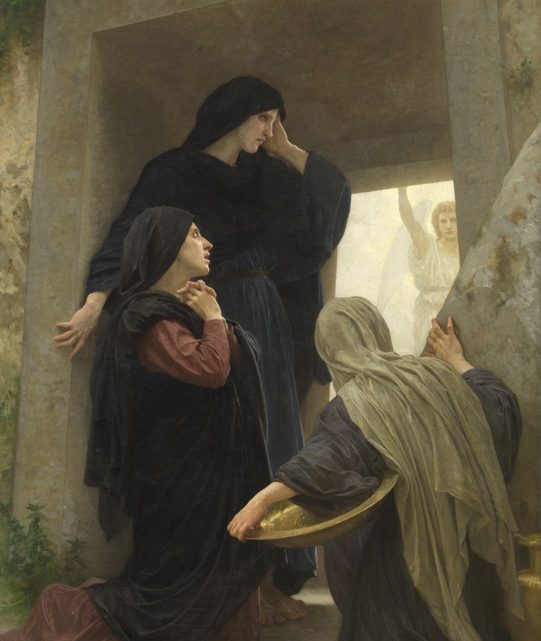Probably more has been written about Mary of Magdala than any other woman scripture, with the possible exception of Mary, the mother of Jesus. There are so many stories, so many ideas about Mary in circulation that it would be difficult to even survey them all. On one extreme, she’s considered to have been a prostitute. On the other, and sometimes by the same people, she is thought to literally have been the wife of Jesus. But of course this latter is not true. Whether or not she was a prostitute… is not so simple.
For all the speculation about her, we really know very little. Scripture does state directly that Jesus had cast seven demons out of her. But precisely how that demon possession manifested itself, we do not know, we are not told.
Magdala, the town from which Mary came, from which she derived her surname, was a fishing town, on the shores of Galilee. Archeologists have determined that fish provided the major source of protein for many Jews in Jesus’ day. Fish caught in the lake were salted and dried in Magdala and then transported elsewhere. Many, of course, went to Jerusalem.
Like sailors everywhere, fishermen were known for their appetites, including sexual ones. Towns filled with sailors, then as now, attracted a number of women whose only means of supporting themselves was to sell their bodies. Possibly, as is all too common today, some young girls were trafficked there and suffered significant trauma. If Mary of Magdala had been one of these, it might well explain her symptoms. Still, we do not know. Scripture is silent on the matter.
But since the town had in those days that reputation, she might well have been assumed to have been a prostitute simply because she came from there. Don’t forget, Nathaniel’s question in John 1:46, “Nazareth! Can anything good come from there?” reminds us that Nazareth also had a bad reputation, though perhaps of a different sort.
What we see in Mary is a woman continually anticipating Jesus needs, and providing for them.
After this, Jesus traveled about from one town and village to another, proclaiming the good news of the kingdom of God.
The Twelve were with him, and also some women who had been cured of evil spirits and diseases: Mary (called Magdalene) from whom seven demons had come out; Joanna the wife of Chuza, the manager of Herod’s household; Susanna; and many others.
These women were helping to support them out of their own means.—Luke 8:1-3.
This is pretty much all we know of Mary of Magdala—until the Crucifixion. The gospels all agree that Mary of Magdala was there, although Luke simply refers to “the women who had followed him from Galilee.” Luke 23:49. In other words, the women he told us about in chapter 8, which we just cited.
All the gospels except John tell us that she accompanied his body to the tomb.
The four Gospels differ in detail about how many and which women went, and at what time, to Jesus’ tomb on Resurrection Morning. The only one they all place there is Mary Magdalene. She went because Jesus’ body had been taken to the tomb just before the Sabbath, and they had not had time to fully prepare it, anointing it with spices. Once there, she discovered the stone had been rolled away from the entrance, and the tomb empty. And she received this commission:
“Do not be alarmed. You seek Jesus of Nazareth, who was crucified. He has risen; he is not here. See the place where they laid him.
But go, tell his disciples and Peter that he is going before you to Galilee. —Mark 16:6, 7.
This passage gives rise to calling Mary Magdalene, “Apostle to the Apostles.” “Go, tell” is the essence of the apostolic commission. She is to go and take the very good news of Jesus’ resurrection to all the male disciples. “Tell his disciples and Peter . . . .” These five words say a great deal. Throughout the gospels, Peter speaks as the representative of the twelve, and he is sometimes tasked with communicating Jesus’ will to the others. But here, even he will be informed by Mary.
As an added irony, scholars generally agree that the source of Mark’s gospel was Peter. It’s possible that Peter, remembering his denial of Jesus, placed himself last in this account as an act of humility. It is also possible that the angel wanted to make certain that Peter realized that Jesus still considered him one of the twelve, and singled him out to be certain he would be informed.
What we see in Mary of Magdala is someone relentlessly conscientious in ministry to Jesus, even to death and beyond. Most of the time her actions attract little or no attention. That matters little to her. She continually shows initiative in the mundane and sometimes distasteful chores of life. After all, when last seen, she intends to anoint a dead body. In the normal course of events, it would have been neither noticed nor mentioned, like the rest of her ministry.
Except for the lower status of women in first century Judaism, we should not be surprised that she received the high honor of being the Apostle to the Apostles, the first human to proclaim the resurrection of Christ. For Jesus had said, “Whoever can be trusted with very little can also be trusted with much.” She had continually been faithful in the small tasks, and so God gave her one of greatest tasks of all times. And made sure the men who wrote the Gospels included it!










